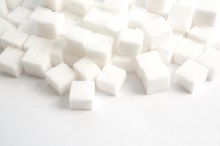How Are Carbohydrates Broken Down?
A powdered-sugar doughnut and a chewy, whole-grain baguette are both carbohydrates, but they are broken down differently by the body. Carbohydrates fall into three basic categories: sugars, starches and cellulose. Simple sugars, or monosaccharies -- such as might be found in your doughnut -- are digested very quickly. More complex di- and polysaccharides are broken down through a series of enzymatic reactions and take longer to digest. Cellulose, which is tough plant fiber, cannot be broken down at all and passes straight through your digestive tract.
Crunchings and Munchings
The breakdown of carbohydrates begins in the mouth, where your teeth tear, grind and mash food into bits small enough to slide down the esophagus. The mashed food is moistened by juicy saliva, which contains digestive enzymes and other chemicals. An enzyme called amylase is instrumental in the digestion of starch, which is broken down into maltose, dextrins and glucose before it leaves your mouth.
Down the Hatch
How Long Does It Take to Digest Gum?
Learn More
Your tongue forces food to the back of your mouth, and as you swallow, the masticated carbohydrates travel through the esophagus to the stomach. The muscular walls churn food together with strong acids that assist in the breakdown of food. The acids are not specific to carbohydrates, so they function in the same way for all macronutrients.
Into the Intestines
Most of the digestive action for carbohydrates happens in the small intestines. Any starches still intact are broken down by more of the amylase enzyme. Maltose, one of the products of starch digestion, is reduced to even smaller pieces called maltase. Sucrose and lactose -- table sugar and milk sugar, respectively -- are digested by sucrase and lactase enzymes. Once di- and polysaccharides have become simple sugar units -- glucose, fructose and galactose -- they are absorbed into the blood stream. The uptake of monosaccharides is regulated by hormones, including insulin, glucagon and epinephrine, which keep your blood sugar stable.
- Most of the digestive action for carbohydrates happens in the small intestines.
- Maltose, one of the products of starch digestion, is reduced to even smaller pieces called maltase.
Life Beyond Digestion
Macromolecules in the Human Digestive System
Learn More
Once simple sugars enter your bloodstream, they are transported elsewhere in your body and become part of metabolic processes. For example, your body is completely dependent on the breakdown of glucose -- through processes called glycolysis and the Krebs cycle -- for energy. The main product of glucose metabolism is adenosine triphosphate, or ATP, which is the energy currency of every cell in your body.
Related Articles
References
- Georgia State University: Carbohydrates
- Introduction to Chemistry: General, Organic, and Biological: Stage I of Catabolism
- Elmhurst College: Overview of Carbohydrate Metabolism
- Carr, T. P., Gropper, S. S., Smith, J. L. (2016). Advanced Nutrition and Human Metabolism. United States: Cengage Learning.
- U.S. Department of Health and Human Services and U.S. Department of Agriculture. 2015–2020 Dietary Guidelines for Americans. 8th Edition. Published December 2015.
Writer Bio
Carolyn Robbins began writing in 2006. Her work appears on various websites and covers various topics including neuroscience, physiology, nutrition and fitness. Robbins graduated with a bachelor of science degree in biology and theology from Saint Vincent College.









